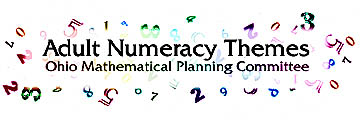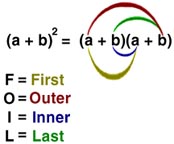| You are here - OLRC | Home | Site Index | Contact Us |
|
||||

Algebra: Patterns and Functions
The area of algebra, both formal and informal, presents a challenging dilemma, because although educators wanted this included, learners often react in a negative manner, with personal stories of frustration and agony. When adults reflect upon what it means to do algebra, they tend to recall formal methods of equation solving, age problems, and lots of X's and Y's. But mathematics educators at all levels have begun a dialogue with a very different emphasis on conceptual understanding, on algebra as a means of representation, and on algebraic methods as a problem solving tool. They are not talking about the mechanical high school algebra but algebraic reasoning that allows us to think about and express patterns, relations and functions and which ultimately gives many more people access to technology.
Many frustrations are connected to past experiences with algebra. Many adults site algebra as a major stumbling block in their earlier math education, the place where they got stuck. Whatever the reason, many learners report an incredible disconnect at the point where algebra is traditionally introduced.
There is a widely held notion that algebra is not practical, relevant or useful. Yet algebra is a bridge between arithmetic and more broadly generalized mathematical situations. Mathematics is the study of patterns. These generalizations can be expressed in the notation of formulas and graphs. Many life and work experiences can be expressed in algebraic terms. While most learners do not see the relevancy of algebra, and many teachers see the academic relevancy, employers and other workers do see the application to today's workplace. Life experience should afford adult basic education teachers with a broad base of real-world ties which can be readily linked to the concepts of equation, function, variable and graph.
Algebraic thinking skills are crucial if adults are to compete in the global economy: therefore all adult learners should have the opportunity to improve in that area. Algebra impacts the competency of workers, parents and citizens. While basic skills are obviously important, it is also useful to have working knowledge of algebraic language. This way of thinking, critically and analytically, contributes to one's daily thought process. Any adult who can think more systematically and analytically is bound to be a better citizen, worker and parent. Better thinkers think ahead. Thinking algebraically influences all areas of our lives.
IMPLICATIONS FOR LEARNING AND TEACHING
It is necessary to introduce all learners to algebraic concepts by making links to the learner's experiences.
We must pay attention to instructional pace, vary teaching strategies and strengthen the development of concepts to improve algebra instruction. It has been suggested that the source of trouble might have to do with the pace of the instruction. Learners, too, need time to assimilate the material and reflect upon it.
Stressing logic puzzles, "function machines", tables and graphs, as well as the concept of what an equation really means are all strategies to help build algebraic thinking.
Graphs and Charts
LARGE GROUP:
Discuss:
What is the purpose of a graph or chart?
![]() quick impression
quick impression
![]() picture display of information
picture display of information
![]() good way to compare information, draw conclusions
good way to compare information, draw conclusions
![]() drawn rather than written
drawn rather than written
Individual:
Demonstrate: Real Graph/ Symbol Graph/ Bar Graph
Pass out 10 tiles to each member of the group.
2. Line them up by color so they make column.
3. Compare the columns.
4. You made a real graph, from real objects.
5. What symbol can we use to represent a tile?
6. Make a graph using the symbol to show how many tiles.
7. Instead of symbols, we can use a bar to show the number of tiles.
8. Draw bars showing the number of tiles. Do your bars go up and down? That is a vertical bar graph. If they go across, that is a horizontal bar graph.
Small Group:
Demonstrate
Circle Graph
Circle graph compares parts of a whole, line graph shows trends
2. The total goes on the bottom and the :red goes on the top.
3. Take number of green tiles over the total.
4. Take the number of black tiles over the total.
5. Make a circle and divide according to fraction. (Hint, you can also convert to percent by dividing the total into the number of colored tiles.)
Large Group:
1. Get information from each group and demonstrate process with results from whole class.
Small group Demonstrate: Line Graph
2. Now, pass out markers, graph paper, and pencils to each group.
Discuss in Large group
Let's look at the things necessary to make a line graph.
We need:
Where can they be found?
Use newspapers, magazines, leaflets, any everyday information you might have that shows graphs.
You may do this as a large group activity and you provide the pictures as a sample OR bring in old magazines and let small groups of students find samples of graphs.
Answer the following questions about the graphs.
Large Group:
Coordinates
Discuss:
2. It's the graphing of points on a plane that allows us to draw graphs or pictures of algebraic expressions.
3. The coordinate plane is the grid (graph paper). Pass out another sheet.
4. The numbers that name the intersection are called ordered pairs. For example, the ordered pair (3,2) names third across, second down.
Always read horizontal, then vertical.
5. These intersections are called points. The ordered pair is always shown in parenthesis.
6. The coordinate plane (grid) has a horizontal plane and a vertical plane which is numbered.
7. The point at which the axis meet is called the origin.
Demonstrate:
2. Plot (1, 1) =A, (1,3)=B, (2,3)=C, (3,2)=D and explain intersection and points as you go. Remember: horizontal then vertical
3. Now let the class draw a 3 by 3 on paper and plot the following:
E= (2,2), F= (3,3), G = (1,2), H= (2, 1)
Cartesian plane using both positive and negative numbers
2. Pass out graph paper.
3. Draw a cross on the board and label 1,2,3, both positive and negative.
4. Show the 4 Quadrants in this graph instead of 1.
5. Plot I= (- 1, 1), J= (3,-2), K= (-2,3) L-- (-3, 1) horizontal then vertical
6. Now, it's your turn. Plot M= (1,- 1), N= (2,3), O= (3,- 1), P= (-2,-3)
Small Group
2. After you have demonstrated how this works, they should be able to play with each other for about 5 minutes.
2. Leader announces "Hurkle is hiding on a point.
3. Group guesses
4. Give dues, N,S,E,W,SW,NE, etc.
5. First team to guess location wins.
ALGEBRA News
Combining Positive Negative Numbers
Use playing card language.
| +4 to the good | -4 in the hole | -4 in the hole | +4 to the good |
| +3 to the good | -3 in the hole | +3 to the good | -3 in the hole |
| +7 to the good | -7 in the hole | -1 in the hole | +1 to the good |
| + + same day | + -mixed up day | |
| - - good day | + - bad day | |
| or |
| (+8) (+4) 1 can go to the store. | = + | |
| (-8) (+4) 1 cannot go to the store. | = - | |
| (+8) (-4) Yes, I cannot go to the store. | = - | |
| (-8) (-4) No, I cannot go to the store. | = + |
Balancing Equations
Algebra as a game
Order of Operations Acronym
Simplify: 6(8 - 11) + 2
ALGEBRA NEWS
Multiplication of Polynomials

PICTURE Method
Regular Multiplication

Setting Up Word Problems
READ - Do you add, subtract, multiply, or divide?
Who or what is involved? Change names to f ones.
READ - Who or what do you know nothing about?
READ - Read backwards in phrases.
EXAMPLE: A contractor needs to order windows for a building she is constructing, The building has four sides and each side requires 53 windows. How many windows will be needed?
Algebra GLOSSARY
ALGEBRA
ALGEBRAIC EXPRESSIONS
EQUATION
EXPONENT
"LIKE TERMS"
NEGATIVE NUMBERS
NUMBER LINE
POLYNOMIAL
POSITIVE NUMBER
"UNLIKE TERMS"
VARIABLES
BIBLIOGRAPHY
Compton's Interactive F-Encyclopedia. Compton's NewMedia Inc., 1994.
Laycock, Mary and Margaret A. Smart. Manipulative Interludes Algebra. Activity Resources Company, Inc., 1990.
Saunders, Hal. When Are We Ever Gonna Have to Use This?. Dale Seymour Publications, 1988.
Stenmark, Jean Kerr, Virginia Thompson, and Ruth Cossey. Family Math. University of California Regents, 1986.
|
|
|
|||||||||
|
| ||||||||||